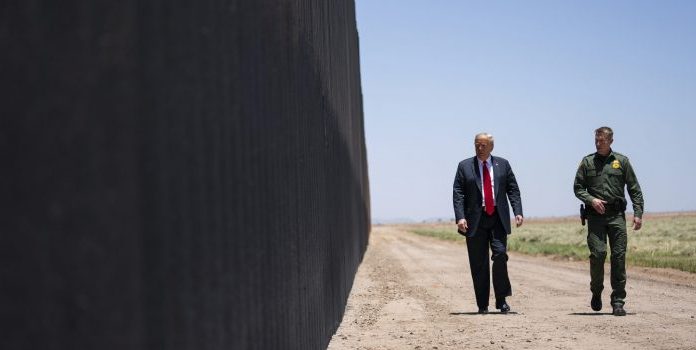(, The Center Square) Dolores Chacón, who lives in the historic home of her great grandparents in what is now the Second Ward of El Paso, says she was a prisoner in her own home until a border fence went up.
The fence was erected behind her home after the Secure Fence Act of 2006 passed with overwhelming Democratic support and was signed into law by former President George W. Bush.
Much of the fence in the El Paso area was built during the Obama administration, and was later replaced by a stronger, taller Trump wall in 2020. But before there was any structure at all, Chacón said foreign nationals ran roughshod through her property, on her roof, broke into and hid inside her home, which backs up to the Texas-Mexico border.
At a recent visit to her home organized by The Texas Public Policy Foundation, Chacón shared what it was like to live on the border under different administrations.
She calls the 2008-era fence that towers over a smaller chain-linked fence with barbed wire bordering the back of her property her “freedom fence.” Because of it, she said, “I got my freedom back.” Prior to the fence, “I was a prisoner in my own home,” afraid to go outside. At the time, she, her mother, daughter and eventually, granddaughter were living there and “were not protected.”
With only a chain-linked fence between her and the Mexican border, people cut through the fence all the time using pliers. “The weekends were even worse,” when men would cut through the fence, bend it and damage it, or “throw themselves over” it. “I had no privacy. I had no freedoms. Nothing, nothing whatsoever,” she said.
“When you lose your freedom, that’s when you want solutions. You have to speak up. When people cannot live freely and enjoy the quality of life that they deserve, it’s shameful,” she lamented. Prior to the fence being built, she’d often clean up blood on the ground left by those who’d illegally entered the U.S. as they passed through her property because they came “injured, shot or stabbed. Her back patio was previously “an open border.”
If it wasn’t for Border Patrol agents, Chacón said she would never have felt safe. She couldn’t leave her home because there were “men on my roof, under my car” and she’d ask them to leave because she needed to go to work. Finally, one Border Patrol agent gave her a device to push a button every time she needed help. Every time she pushed it, an agent came.
“God bless Border Patrol,” she said. Every time she sent a signal, an agent came and picked up men who’d illegally entered from Mexico who were on her property.
“It was madness. It was insane. Nobody should live under those conditions. My property was damaged. My roof was damaged. Nobody paid me back. Why do I stay here? Because it’s my home,” she said.
Former Border Patrol Chief Rodney Scott explained the purpose of a border barrier “is to slow down the criminal activity to the point that Border Patrol agents can respond before they [illegal foreign nationals] can do significant damage and get into your house.”
Border barriers and wall construction evolved over decades and the fence put up behind Chacón’s home, Scott said, was another version installed in urban areas “where we thought we needed to see through it.” At the time, “battery operated power tools were basically non-existent or super expensive. They were barely starting to come out on the market. You could not buy them at Home Depot for a hundred bucks.”
But once battery-operated power tools became easily accessible, “you could cut a hole through this in about 20 to 30 seconds, depending on the battery-operated tool,” he explained. The Trump wall, which was larger, thicker and cemented in concrete below the surface was much more effective, he added. A portion of it is located on the other side of the highway farther behind the two fences in Chacón’s back yard.
Chacón said Trump’s border policies made her feel safe. “With the Trump policies, you didn’t have all of the homeless people,” she said, referring to those released onto the streets by the Biden administration near Sacred Heart Roman Catholic Church a few blocks away. “You didn’t have the crime.”
Because of the Trump wall, Remain in Mexico and other policies, Chacón said there was less crime in the neighborhood. When asked if she noticed a difference after President Joe Biden took office, she said, “Yes, we saw it right away. It’s a disaster.”
Scott said that “urban areas like this are always more of a threat because [residents will] call Border Patrol, but some of the neighbors may not.” Cartel smugglers may have bought or rented a house one block over so that those coming across have a place to “quickly get across and then hide, settle down for a few minutes, let law enforcement cool off and then have a car come in and get out.
“These areas are always very high priority for the smugglers especially if you’re carrying a commodity. Just think if you’re a drug smuggler, and you can get close to the other side of this fence in today’s environment, if you have somebody on the north side that’s renting a house, all you have to do is have one of those slingshot launchers to shoot little balls of heroin, methamphetamines, fentanyl or whatever.
“All that was factored into the new border wall system, including the height, under the Trump administration,” he said, “and unfortunately, [President] Biden shut it all off and opened our borders.”

